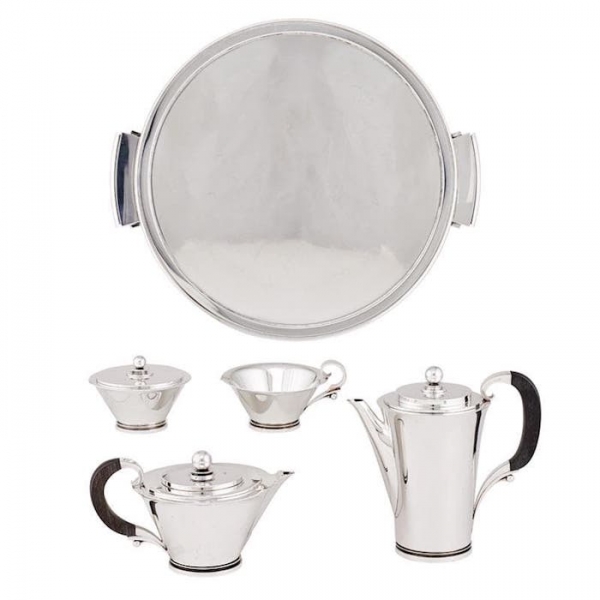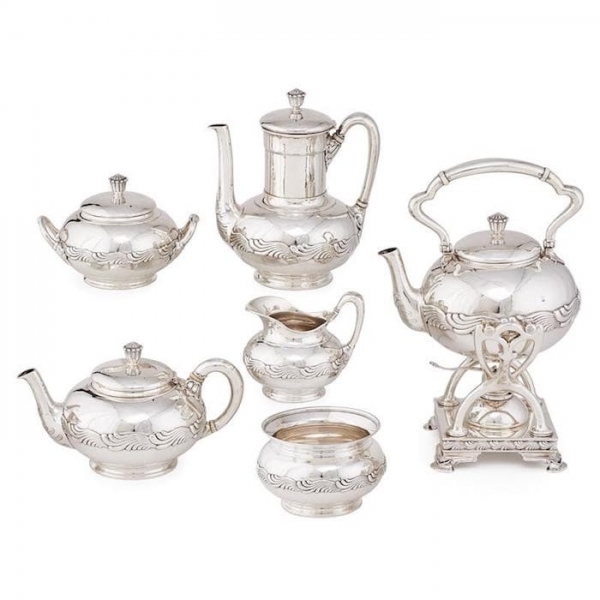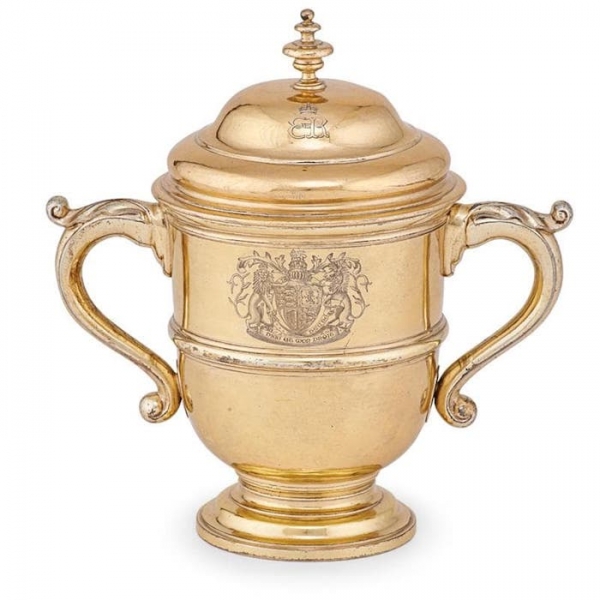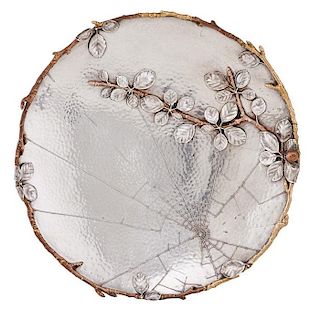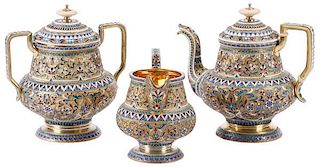Silver Linings: A Crash Course in Silver with Jenny Pitman
Humanity’s love of silver is well documented. Archeologists have discovered examples of silver ornamentation dating to 4000 B.C.
Odds are good that there are examples of silver ornamentation among your possessions, as well. But what do you know about this alluring metal? And what factors determine the worth of objects shaped from and adorned by it?
The following blog is informed by a presentation delivered by Jenny Pitman, formerly the silver department director at Christie’s and currently Rago’s representative in Westchester and Connecticut, at the Historical Society of Princeton in March of 2018.
Lot 2012, Georg Jensen, Sterling Silver Tea & Coffee Service; Estimate $6,000 - $9,000
Silver Quality Standards
Silver is a soft metal that is easy to work with but lacking in durability. As such it is often alloyed with other metals, primarily copper, for greater strength and durability. The ratios of silver to other metals informs the ‘quality’ of the silver and is communicated as a ‘quality stamp’ impressed into the object, typically tucked out of sight on the back or underside of the piece. Common quality stamps include…
Fine .999 Silver: 999/1000 parts silver. The closest standard to pure elemental silver. Often appears gray and slightly dull and is exceptionally easy to scratch or dent.
Sterling .925 Silver: 925/1000 parts silver. The most familiar standard, mandated by statue in England circa 1300. This is the standard most commonly used in the production of jewelry.
Britannia Silver: 958/1000 parts silver. This standard was used in England 1697-1720 and is associated with makers such as Paul de Lamerie.
Continental Silver: A variety of standards were used in Europe, collectively referred to as Continental Silver. France used 958/1000 parts silver, and later 950/1000 and 800/1000; Germany used 750/1000 to 937/1000 parts silver, and later 800/1000.
Coin Silver: 900/1000 parts silver. American silversmiths used this standard until circa 1850. The term refers to the melting down of silver coins to manufacture an object. Circa 1850, American silversmiths began to move away from the use of coin silver and conform to the sterling standard.
Lot 2168, Tiffany & Co. Sterling Silver Tea & Coffee Service; $2,500 - $3,500
Silver Plating
The practice of silver plating originated in the 18th century as a means of producing cheaper versions of household items that would typically be made of solid silver, including cutlery, candlesticks and vessels.
Methods of silver plating include:
Sheffield Plate: The earliest form of silver plating in which sterling silver was fused to a base metal, in use from 1750-1840. Typically, a copper ingot was covered in silver, fused and flattened into a sheet. The sheet was then fashioned into an object. To save cost, often only one side was plated with silver, while the base or interior was lined with tin. As the piece aged, the silver coating began to wear, exposing the copper base, a process known as “bleeding.” Other telltale signs of Sheffield plate include rolled over edges, joined seams on handles and feet, and silver disk inserts for monograms or arms. Sheffield plate was often unmarked. Matthew Boulton was the most famous Sheffield plate maker; his mark consisted of two sunbursts.
Electroplating: This process replaced Sheffield plating, circa 1840, as it was much more cost effective. In this process an object formed out of a base metal, such as nickel, was coated with a layer of silver through electrolysis. The electric current applied an all-over silver coating so there are no seams to disguise the application. Elkington and Christofle were the most prominent electroplate manufactures. Silver plate is often marked EPNS (elector plated nickel silver), EP (electro plate), A1, triple plate, or quadruple plate.
Gilding: The application of a thin layer of gold on top of a base of silver, also known as silver-gilt. Originally achieved by applying an amalgam of mercury and gold leaf to an object, then heating it, causing the mercury to evaporate away. This toxic process was replaced by electro gilding in the mid-19th century. Objects that are only partially gilt are refeed to as parcel-gilt.
Lot 2403, Pair of English Sterling Silver Four-Light Candelabra; Estimate $3,000 - $5,000
Decorative Techniques
Over the course of several thousand years, artisans working in silver have developed a litany of techniques for shaping and decorating their creations, common among these:
Repoussé /Chasing: A process for creating relief decoration by pushing the silver outward (repousse) or inward (chasing). No metal is removed in this process.
Casting: Decorative elements, spouts, handles, feet etc. are fully cast and soldered to the object.
Engraving: A sharp tool is used to cut into the metal to create a design, coat-of-arms, or initials. Metal is removed in this process.
Bright Cutting: Sharp, shallow angled cuts are used to create a designs in the silver that sparkle in the light. Popular during the neo-classical period, utilized extensively by silversmiths including Hester Bateman. Metal is removed in this process.
Lot 2397, George I Silver-Gilt, Two-handled Cup and Cover; Estimate $2,000 - $4,000
Marks on Silver
The marks on English and European silver are well documented due to hallmarking laws, which ensured that silver met the specified standard, and enforced through local assay offices. Colonial silversmiths generally marked their piece with their initials.
Marks on English silver typically include:
Maker’s Mark: Introduced in the 14th century, this mark (typically consisting of the maker’s initials) identified the silversmith who created the piece. For the Britannia standard, the first two letters of the silversmith’s name were used.
Standard Mark: Introduced in the 16th century as a way of differentiating silver quality standards. The ‘lion passant’ (walking lion) signified the silver was sterling standard. A lion’s head with a jagged neck signified Britannia standard.
Town Mark: Signified the town in which the silver was assayed. A leopard head signifies London, an anchor signifies Birmingham, a crown signifies Sheffield, a harp signifies Dublin and three castles signify Edinburgh.
Date Letter: Introduced in the 15th century to identify the assay master responsible for testing the silver as well as the year a piece was manufactured. Consist of a series of letters. Variations to the font and the surrounding shield help distinguish the year.
Duty Mark: Used from 1784-1890 to indicate a required tax had been paid. As this mark depicts the head of the reigning sovereign at the time of production, it’s useful for quickly identifying and dating silver produced during the later Georgian/Victorian era.
Assay Scrape: Silver removed from the object for testing. English scrapes are shallow and broad, Continental are zig-zag shaped.
Scratch weight: Indicates the weight of an object, typically found on the underside of a piece of silver. Silver is measured in grams, troy ounces and pennyweights.
One troy oz. = 1.097 avoirdupois oz. or 31.1 gr.
20 penny weights (dwt.) = one troy oz.; twelve troy oz. = 1 troy pound
Browse over 40 works of silver, including antique and modern designs by Tiffany & Co., Kalo, Georg Jensen and more, in Rago's, Remix: Contemporary + Classic sale on April 7th.
Don't have a Bidsquare account? Sign up here!
Be in the know about upcoming auctions and exciting post-sale results by following us on Facebook and Instagram.
- Rafael Osona Auctions' Modern & 19th Century Design From Nantucket Estates
- Bidsquare Appoints Traci Lombardo as CEO, Reinforcing Founding Commitment to Auctioneers
- Quilts as a 2025 Design Trend: A Celebration of American Heritage and Craftsmanship
- A Celebration of Sports History and Collectibles
- The Thrill of Sports Memorabilia Auctions: A Collector’s Paradise
- Demystifying Coin Condition: A Guide to the Sheldon Grading Scale
- Snoopy & Friends: A “Peanuts” Auction at Revere
- Colorful Chinese Monochromes at Millea Bros
- 12 Holiday Gifts for the “Impossible to Buy For” on Bidsquare
- Alluring Art Objects and Accessories from the Estate of Chara Schreyer



 EUR
EUR CAD
CAD AUD
AUD GBP
GBP MXN
MXN HKD
HKD CNY
CNY MYR
MYR SEK
SEK SGD
SGD CHF
CHF THB
THB